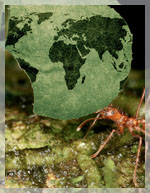Biogeography of Ants
Effect of urbanization and invasive species
One of the main goal of ecology is to try and link pattern and process at the community scale, where most experimental ecology takes place, with geographic patterns of species occurrence. In the modern world, humans are leaving an ever expanding urban footprint due to population growth and expansion, and the global economy and movement of people and resources is further modifying the environment by the introduction of species to areas and ecosystems in which they have no evolutionary history.
My research seeks to link the fields of urban ecology, invasion biology, and biogeography. I am using two databases of ant diversity; the global ant diversity database and the North American ant database in collaboration with Rob Dunn and colleagues. Initially I am looking at how urbanization acts as a driver of ant diversity, if urban ant communities demonstrate the typical latitudinal gradient in diversity, and how urbanization and introduced species alter ranges of native species.
PDF - A global database of ant species abundances
PDF - Climate mediates the effects of disturbance on ant assemblage structure
PDF - Global diversity in light of climate change: the case of ants
PDF - Canopy and litter ant assemblages share similar climate-species density relationships
PDF - Climatic drivers of hemispheric asymmetry in global patterns of ant species richness

